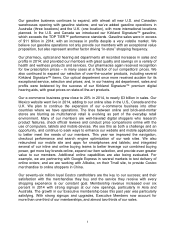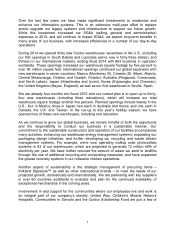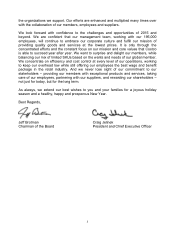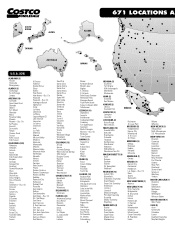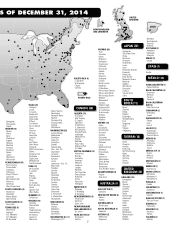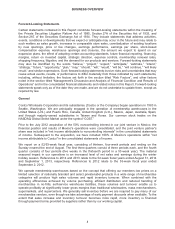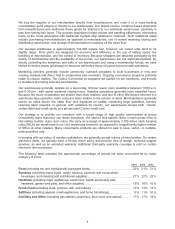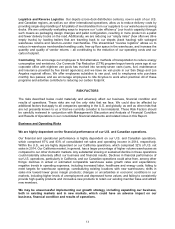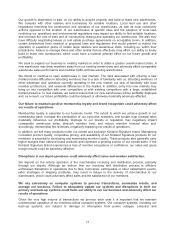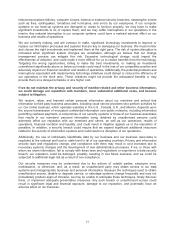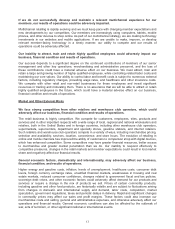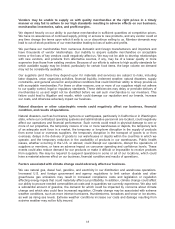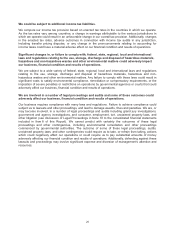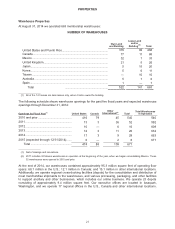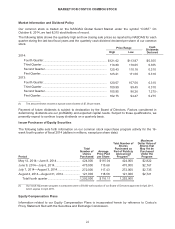Costco 2014 Annual Report Download - page 15
Download and view the complete annual report
Please find page 15 of the 2014 Costco annual report below. You can navigate through the pages in the report by either clicking on the pages listed below, or by using the keyword search tool below to find specific information within the annual report.
Logistics and Reverse Logistics Our depots (cross-dock distribution centers), now in each of our U.S.
and Canadian regions, as well as our other international operations, allow us to reduce delivery costs by
providing single-step handling of full pallets of merchandise from our suppliers to our warehouse receiving
docks. We are continually evaluating ways to improve our “cube efficiency” (our truck’s capacity) through
such means as packaging design changes and pallet configuration, resulting in more product on a pallet
and fewer delivery trucks on the road. Additionally, we are reducing our “empty miles” (how often we drive
empty trucks) by loading trailers that are traveling back to our depots (back hauling) with salvaged
warehouse returns and return-to-vendor merchandise. This streamlined “reverse logistics” allows us to
reduce in-warehouse merchandise handling costs, free-up floor space in the warehouse, and increase the
quantity and quality of vendor returns – all contributing to the reduction of our operating costs and our
carbon footprint.
Commuting We encourage our employees to find alternative methods of transportation to reduce energy
consumption and emissions. Our Commute Trip Reduction (CTR) program begun twenty years ago at our
corporate office with eighteen van pools has evolved into seventy-seven vans (vans, fuel, maintenance
and insurance provided by five transit agencies); and we have six van pools in our San Diego and Los
Angeles regional offices. We offer employees subsidies to van pool, and to employees who purchase
monthly bus passes; and we encourage employees to ride bicycles to work when practical. All of these
programs and activities contribute to reducing our carbon footprint.
RISK FACTORS
The risks described below could materially and adversely affect our business, financial condition and
results of operations. These risks are not the only risks that we face. We could also be affected by
additional factors that apply to all companies operating in the U.S. and globally, as well as other risks that
are not presently known to us or that we currently consider to be immaterial. These Risk Factors should
be carefully reviewed in conjunction with Management's Discussion and Analysis of Financial Condition
and Results of Operations in our consolidated financial statements and related notes in this Report.
Business and Operating Risks
We are highly dependent on the financial performance of our U.S. and Canadian operations.
Our financial and operational performance is highly dependent on our U.S. and Canadian operations,
which comprised 87% and 83% of consolidated net sales and operating income in 2014, respectively.
Within the U.S., we are highly dependent on our California operations, which comprised 32% of U.S. net
sales in 2014. Our California market, in general, has a larger percentage of higher volume warehouses as
compared to our other domestic markets. Any substantial slowing or sustained decline in these operations
could materially adversely affect our business and financial results. Declines in financial performance of
our U.S. operations, particularly in California, and our Canadian operations could arise from, among other
things: declines in actual or estimated comparable warehouse sales growth rates and expectations;
negative trends in operating expenses, including increased labor, healthcare and energy costs; failing to
meet targets for warehouse openings; cannibalizing existing locations with new warehouses; shifts in
sales mix toward lower gross margin products; changes or uncertainties in economic conditions in our
markets, including higher levels of unemployment and depressed home values; and failing to consistently
provide high quality products and innovative new products to retain our existing member base and attract
new members.
We may be unsuccessful implementing our growth strategy, including expanding our business,
both in existing markets and in new markets, which could have an adverse impact on our
business, financial condition and results of operations.
13


